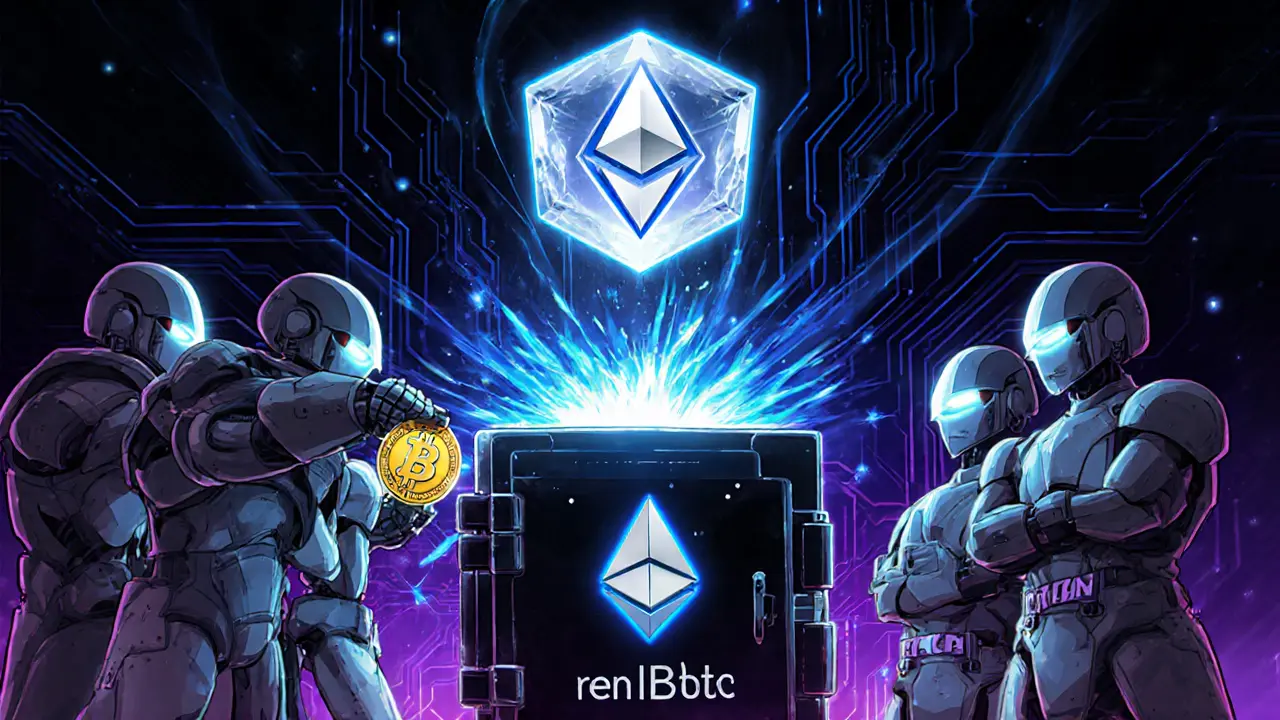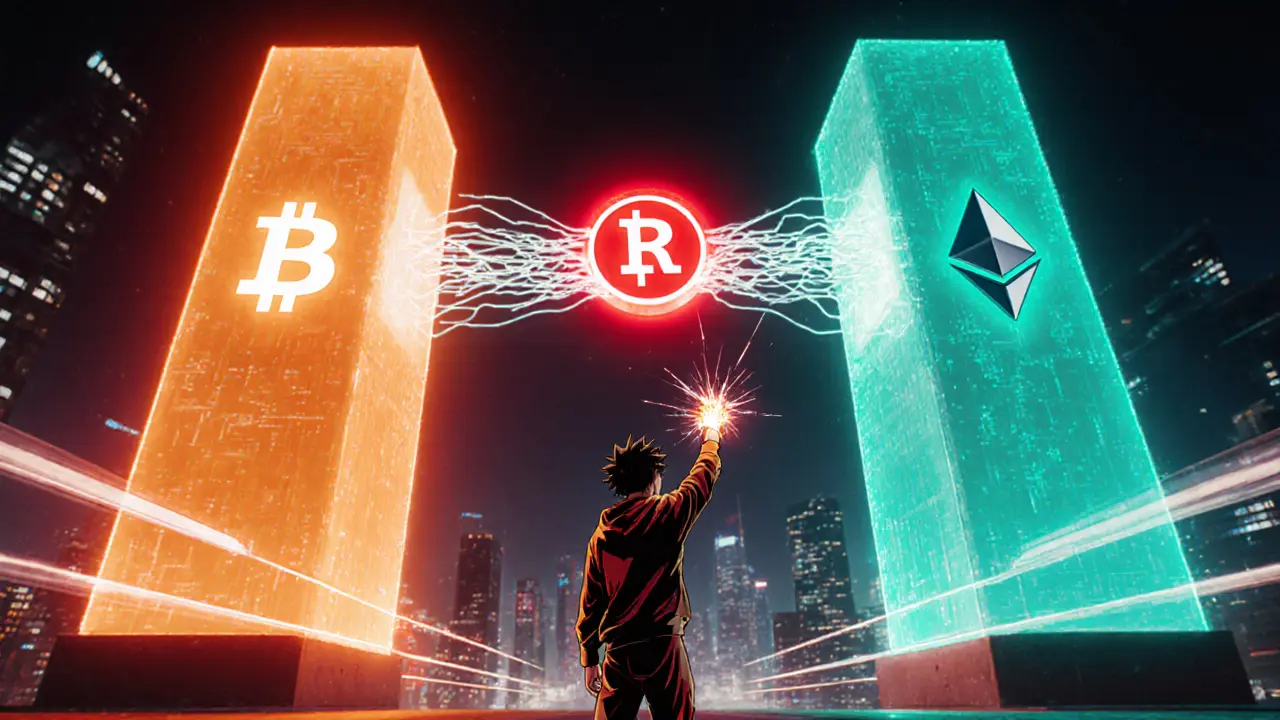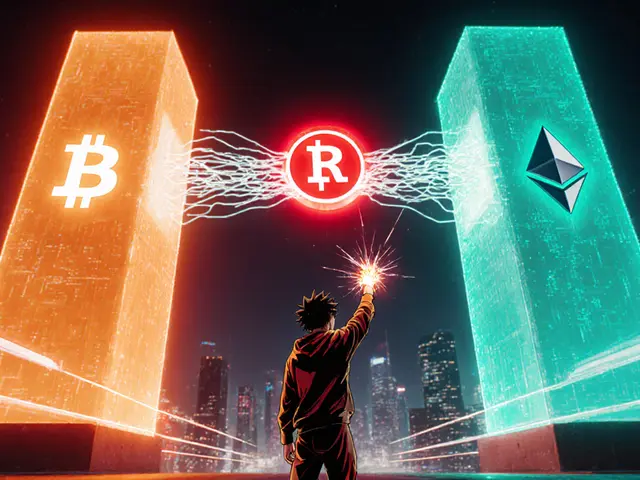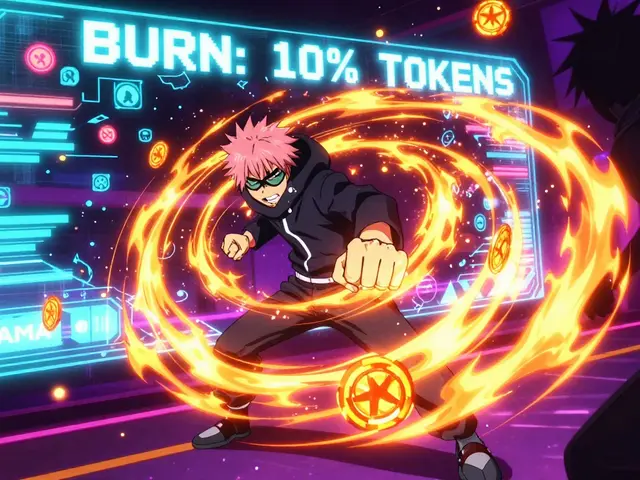Ren (REN) Token Value Calculator
Portfolio Value
$0.00
Based on current holdings and price
Daily Network Revenue
$0.00
Estimated from transaction fees
Decentralized Security
100,000 REN collateral per Darknode ensures network integrity and prevents malicious behavior.
Privacy Preserved
zkSNARKs and MPC keep transaction details private while maintaining trustlessness.
Cross-Chain Interoperability
Transfer assets between Bitcoin, Ethereum, BSC, and more without intermediaries.
Ever wondered how you can move Bitcoin onto Ethereum without giving up control? That’s the problem Ren crypto tries to solve. In simple terms, Ren is a decentralized protocol that lets you transfer value across blockchains while keeping privacy and trustlessness intact.
What Is Ren (REN)?
Ren (REN) is an ERC‑20 utility token that powers the RenVM ecosystem. Launched in 2020 after rebranding from Republic Protocol, Ren’s main goal is to provide cross‑chain interoperability - the ability for assets on one blockchain to be used on another without a centralized bridge.
Unlike traditional wrapped tokens that rely on a custodian, Ren’s approach is fully decentralized. The token itself doesn’t function as a store of value like Bitcoin; instead, it grants access to the network’s computational work and secures the protocol through economic incentives.
Core Technology: RenVM
RenVM is the heart of the system, a decentralized virtual machine that runs cross‑chain contracts in zero‑knowledge. It combines two cutting‑edge cryptographic tools: zkSNARK (a succinct proof system that validates transactions without revealing data) and Secure Multi‑Party Computation (MPC) (a method where multiple parties jointly compute a function while keeping their inputs private)
When you lock Bitcoin on its native chain, RenVM’s MPC nodes collectively generate a secret, mint a corresponding ERC‑20 token (e.g., renBTC) on Ethereum, and provide a zkSNARK proof that the operation was valid. The proof is instantly verifiable on‑chain, meaning no one has to trust a single party.
How RenVM Enables Cross‑Chain Transfers
The process can be broken down into three steps:
- Lock: Your original asset (e.g., BTC) is sent to a smart contract on its native chain.
- Mint: RenVM’s Darknodes compute a secret, generate a proof, and mint the equivalent ERC‑20 token on the destination chain.
- Release: When you want to retrieve the original asset, you burn the ERC‑20 token, and RenVM releases the locked Bitcoin back to your address.
This flow preserves ownership throughout, and thanks to zero‑knowledge proofs, the network can scale without leaking transaction details.

The REN Token and Its Economics
The REN token serves multiple economic roles:
- Bonding: Darknode operators must stake exactly 100,000 REN as collateral. This bond discourages malicious behavior because a dishonest node would lose its entire stake.
- Fee Payments: Transaction fees are paid in REN, creating a demand side for the token.
- Incentive Alignment: Traders and order‑matching nodes also post REN bonds, forming a market where honest computation is rewarded through fee capture rather than inflationary rewards.
Unlike many proof‑of‑stake networks, REN does not emit regular staking rewards. Operators earn income solely from transaction fees and the value of the bonds they hold.
Darknodes: The Decentralized Guardians
Darknodes are the specialized nodes that run RenVM’s MPC protocol. To spin up a Darknode you need to lock 100,000 REN, proof of identity is not required, but the high collateral creates a natural barrier to Sybil attacks.
Darknodes collectively generate the secret used in the mint/release steps and verify zkSNARK proofs. Their security model assumes that less than 50% of nodes are malicious; if that threshold is crossed, the network’s guarantees degrade to those of an ideal world protocol.
Because there are no direct staking rewards, the ecosystem relies on a healthy fee market and the intrinsic value of the REN token to attract and retain node operators.
Real‑World Use Cases in DeFi
Ren’s cross‑chain capability unlocks several practical scenarios:
- Yield Farming on Ethereum with Bitcoin: Users can lock BTC, receive renBTC, and supply it to Ethereum‑based liquidity pools, earning yields without selling their Bitcoin.
- Cross‑Chain Collateral: Decentralized loans can accept assets from multiple chains as collateral, expanding capital efficiency.
- Privacy‑Preserving Swaps: The zero‑knowledge layer lets users trade across chains without exposing transaction amounts on public ledgers.
These applications have attracted interest from major DeFi platforms, including Curve, SushiSwap, and Aave.
Competitive Landscape and Alternatives
Ren isn’t the only bridge player. Below is a quick comparison of Ren, Wrapped Bitcoin (WBTC), and the Polygon Bridge.
| Feature | Ren | Wrapped Bitcoin (WBTC) | Polygon Bridge |
|---|---|---|---|
| Decentralization | Fully decentralized (MPC + zkSNARK) | Centralized custodian | Hybrid (validators + contracts) |
| Privacy | Zero‑knowledge proofs hide amounts | Transparent | Transparent |
| Supported Chains | BTC, BCH, ZEC, ETH, BSC, others (growing) | BTC → ERC‑20 only | Ethereum ↔ Polygon |
| Collateral Requirement | 100,000 REN per Darknode | None for users | None for users |
| Staking Rewards | No direct rewards | None | Validator rewards exist |
Ren’s strong privacy model and fully trustless design set it apart, but the high entry barrier for node operators can limit network decentralization compared to lighter solutions.

Risks and Challenges
Several factors could affect Ren’s long‑term viability:
- Operator Barrier: Staking 100,000 REN (~$10,900 at today’s price) may deter smaller participants, concentrating power.
- No Staking Rewards: Operators depend on fee volume, which can be volatile during market downturns.
- Competitive Pressure: Newer layer‑0 solutions (e.g., Cosmos, Polkadot) aim to solve the same interoperability problem with different models.
- Regulatory Uncertainty: Cross‑chain bridges have attracted regulatory scrutiny due to potential for money‑laundering.
Understanding these risks is crucial before allocating capital to REN or building on RenVM.
Recent Developments & Future Outlook
In February 2022, Ren joined Alameda Research (a quantitative trading firm linked to the FTX ecosystem)
The partnership promised additional funding and accelerated development. However, Alameda’s collapse after the FTX bankruptcy in November 2022 introduced uncertainty about Ren’s financing and governance.
Despite that setback, the protocol has continued releasing updates. As of October 2025, RenVM supports Bitcoin, Bitcoin Cash, Zcash, Ethereum, Binance Smart Chain, and several emerging L‑1s. The team is actively working on adding Solana and Avalanche support, aiming to broaden liquidity channels.
Market data shows REN trading around $0.11 with modest daily volume. Community activity remains healthy across Twitter, Telegram, and Reddit, indicating ongoing interest from developers and traders alike.
Looking ahead, Ren’s success hinges on three factors: expanding chain support, maintaining a vibrant Darknode ecosystem, and navigating the regulatory landscape for cross‑chain bridges.
Quick Takeaways
- Ren (REN) powers a decentralized, privacy‑preserving cross‑chain bridge called RenVM.
- Darknodes secure the network by staking 100,000 REN each; there are no traditional staking rewards.
- Zero‑knowledge proofs (zkSNARK) and MPC enable trustless asset swaps without a custodian.
- Ren competes with wrapped token solutions but offers stronger decentralization and privacy.
- Risks include high entry barriers, fee‑dependent node incentives, and regulatory uncertainty.
Frequently Asked Questions
What does the REN token do?
REN is an ERC‑20 utility token that secures the RenVM network through bonding, pays transaction fees, and aligns incentives for Darknode operators and traders.
How is a Bitcoin transferred to Ethereum using Ren?
You lock BTC in a native Bitcoin contract, RenVM’s Darknodes generate a zkSNARK proof and mint an ERC‑20 token called renBTC on Ethereum. To reverse the process, you burn renBTC and the locked BTC is released.
Do Darknode operators earn rewards?
Operators earn fees from every transaction they help verify. There are no inflationary staking rewards; income depends on network activity.
Is RenVM’s privacy truly anonymous?
RenVM uses zkSNARKs, which hide transaction amounts and participant addresses from the public chain. However, on‑chain activity (like contract calls) can still be linked with external analysis.
Can I use Ren without running a Darknode?
Yes. End users simply interact with wallets or DeFi platforms that integrate Ren. The heavy lifting is done by Darknodes in the background.
What are the main competitors to Ren?
Key rivals include Wrapped Bitcoin (WBTC), the Polygon Bridge, Cosmos IBC, and emerging layer‑0 solutions like Polkadot’s parachains.
How secure is RenVM against attacks?
Security relies on the honest majority of Darknodes. As long as less than 50% of nodes collude, the MPC and zkSNARK proofs remain mathematically sound.









Comments (16)
Brian Lisk
October 7, 2025 AT 08:53 AMRenVM presents a fascinating blend of cryptographic innovation and practical utility, and its design choices deserve a thorough look. The protocol leverages zkSNARKs to keep transaction amounts hidden, which is a rare feature among cross‑chain bridges. At the same time, Secure Multi‑Party Computation distributes trust across many Darknodes, preventing any single point of failure. Users can lock Bitcoin on its native chain and receive renBTC on Ethereum without surrendering custody. This process preserves ownership while enabling participation in DeFi yield farms that would otherwise be inaccessible to BTC holders. Darknode operators must stake exactly 100,000 REN, creating a substantial economic bond that aligns incentives. Because there are no inflationary staking rewards, operators rely entirely on transaction fees for income, which can fluctuate with market activity. The high collateral requirement can deter smaller participants, potentially centralizing the network among well‑capitalized entities. Nonetheless, the open‑source nature of RenVM invites community contributions and auditability. Recent updates have expanded support to additional L‑1s such as Avalanche and Solana, broadening the ecosystem. The partnership with Alameda Research injected capital but also highlighted the risks of relying on a single backer. Despite that setback, the development team continued to ship improvements, demonstrating resilience. Privacy remains a core differentiator; zkSNARK proofs verify transfers without exposing underlying data. However, regulators are increasingly scrutinizing cross‑chain bridges for AML concerns, which could affect future adoption. In summary, Ren offers strong privacy and decentralization at the cost of higher entry barriers for node operators. Investors should weigh the fee‑dependent revenue model against the competitive landscape of bridges. Overall, the technology is sound, and its continued evolution will determine long‑term relevance.
Darren Belisle
October 7, 2025 AT 10:33 AMWow, the way Ren hides amounts, while still moving value, is just, absolutely, mind‑blowing!
Heather Zappella
October 7, 2025 AT 12:13 PMRen’s architecture elegantly combines privacy and interoperability, making it a valuable tool for developers seeking to build cross‑chain DeFi applications. The use of zero‑knowledge proofs ensures that transaction details remain confidential, which aligns well with regulatory compliance efforts that focus on user privacy. Moreover, the token economics, where fees are paid in REN, creates a natural demand for the token that can support sustainable network growth. It’s also worth noting that the absence of inflationary rewards encourages operators to prioritize efficiency and fee generation.
Kate O'Brien
October 7, 2025 AT 13:53 PMLook, the whole thing feels like the secret service is behind it, and I’m not trusting any of it. They say it’s private, but who’s watching the watchers? If you don’t run a Darknode, you’re just a puppet in their game. It’s scary.
Ricky Xibey
October 7, 2025 AT 15:33 PMRen’s cool if you want to move BTC to Ethereum without a middleman.
Sal Sam
October 7, 2025 AT 17:13 PMFrom a technical standpoint, RenVM’s MPC layer orchestrates secret sharing among nodes, while zkSNARKs provide succinct verification. This dual‑layer approach mitigates centralization risks and enhances throughput, which is crucial for high‑frequency DeFi protocols that require low latency. Additionally, the fee model aligns operator incentives directly with network usage, fostering a market‑driven scaling dynamic.
Moses Yeo
October 7, 2025 AT 18:53 PMOne might argue that the very notion of trustless bridges is a philosophical illusion; after all, trust is merely shifted, not eliminated-so consider the paradox of decentralized control.
Richard Bocchinfuso
October 7, 2025 AT 20:33 PMi cant believe ppl still think this is safe, it's just another way for the elites to pull the rug.
Jason Wuchenich
October 7, 2025 AT 22:13 PMKeep experimenting with Ren and share your results; progress comes from community effort.
Lara Decker
October 7, 2025 AT 23:53 PMThe data shows Ren’s usage spikes only during market rallies, which suggests speculative motives dominate.
Anna Engel
October 8, 2025 AT 01:33 AMOh great, another “decentralized” bridge that pretends to be revolutionary while copying the same old ideas.
manika nathaemploy
October 8, 2025 AT 03:13 AMHey guys, i think ren is pretty interesting, but i also worry about the 100k token lock. It feels risky for small holders.
Mark Bosky
October 8, 2025 AT 04:53 AMRenVM’s protocol design warrants rigorous academic scrutiny, particularly concerning the security assumptions underpinning its multi‑party computation framework.
Marcus Henderson
October 8, 2025 AT 06:33 AMFrom a philosophical perspective, Ren exemplifies the pursuit of trust‑minimized coordination, yet it simultaneously underscores the perennial tension between accessibility and decentralization.
Debra Sears
October 8, 2025 AT 08:13 AMRen’s future hinges on broader chain integration, and I’m hopeful we’ll see more native support soon.
Andrew Lin
October 8, 2025 AT 09:53 AMAmerica’s finest tech should dominate this space, and anyone not using Ren is just lagging behind-obviously.